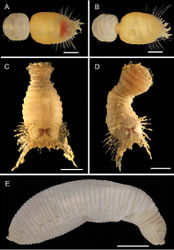Sternaspis cf. annenkovae
| Notice: | This page is derived from the original publication listed below, whose author(s) should always be credited. Further contributors may edit and improve the content of this page and, consequently, need to be credited as well (see page history). Any assessment of factual correctness requires a careful review of the original article as well as of subsequent contributions.
If you are uncertain whether your planned contribution is correct or not, we suggest that you use the associated discussion page instead of editing the page directly. This page should be cited as follows (rationale):
Citation formats to copy and paste
BibTeX: @article{Gunton2021ZooKeys1020, RIS/ Endnote: TY - JOUR Wikipedia/ Citizendium: <ref name="Gunton2021ZooKeys1020">{{Citation See also the citation download page at the journal. |
Ordo: Phyllodocida
Familia: Sternaspidae
Genus: Sternaspis
Name
Sternaspis annenkovae Salazar-Vallejo & Buzhinskaja, 2013 – Wikispecies link – Pensoft Profile
Diagnosis
Body ~ 11.5 mm long and 5 mm wide. Segments between introvert and rest of body appearing cinched. Body covered in fine papillae largest and densest on segments 7 and 8. Ventro-caudal shield ribbed and concentrically ringed.
Remarks
For further details see Drennan et al. (2019)[1].
Records
2 specimens. Suppl. material 1 op. 40 (NHMUK).
Taxon Treatment
- Gunton, L; Kupriyanova, E; Alvestad, T; Avery, L; Blake, J; Biriukova, O; Böggemann, M; Borisova, P; Budaeva, N; Burghardt, I; Capa, M; Georgieva, M; Glasby, C; Hsueh, P; Hutchings, P; Jimi, N; Kongsrud, J; Langeneck, J; Meißner, K; Murray, A; Nikolic, M; Paxton, H; Ramos, D; Schulze, A; Sobczyk, R; Watson, C; Wiklund, H; Wilson, R; Zhadan, A; Zhang, J; 2021: Annelids of the eastern Australian abyss collected by the 2017 RV ‘Investigator’ voyage ZooKeys, 1020: 1-198. doi
Images
|
Other References
- ↑ Drennan R, Wiklund H, Rouse G, Georgieva M, Wu X, Kobayashi G, Yoshino K, Glover A (2019) Taxonomy and phylogeny of mud owls (Annelida: Sternaspidae), including a new synonymy and new records from the Southern Ocean, North East Atlantic Ocean and Pacific Ocean: challenges in morphological delimitation.Marine Biodiversity49: 2659–2697. https://doi.org/10.1007/s12526-019-00998-0
